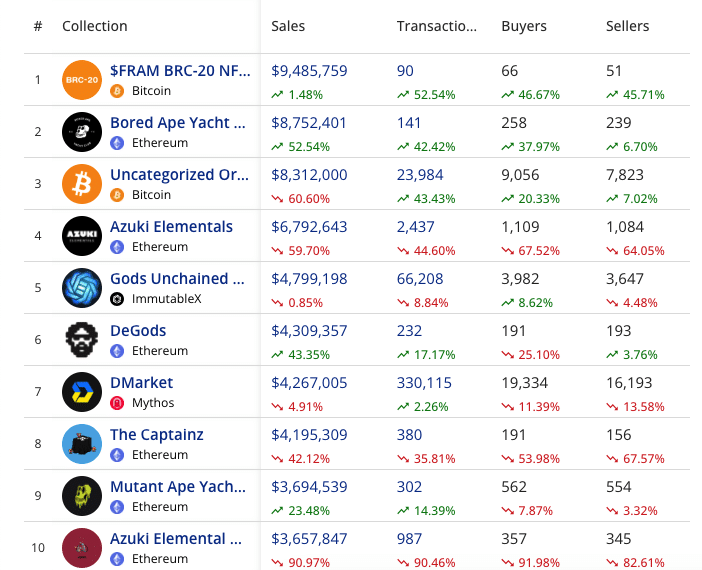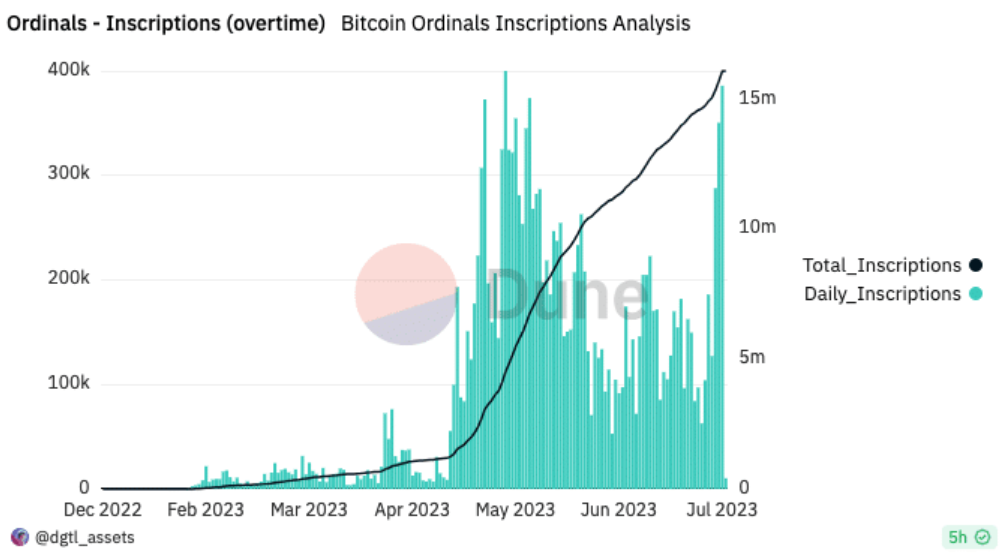- Bitcoin Ordinals, which represents NFTs created on the Bitcoin network, appears to be closing in on its competitors in terms of dominance in the NFT space.
- Previously, Ethereum held the title of volume king in the realm of NFTs, thanks to the momentum it gained during the mass adoption process in 2021.
- Bitcoin Ordinals didn’t limit its activity to just its initial application. The recent introduction of Inscriptions led to the emergence of BRC-20 fungible tokens.
The significant growth in activity within Bitcoin Ordinals NFTs strengthens the possibility of challenging Ethereum’s dominance in the NFT space.
Rapid Growth in Bitcoin Ordinals NFT Sales

Bitcoin Ordinals, representing NFTs created on the Bitcoin network, appears to be closing in on its competitors in terms of dominance in the NFT space. According to data, Bitcoin NFT sales have increased by 8301% in the last 24 hours. This stands in stark contrast to the mere 1.33% increase in volume recorded on the Ethereum blockchain during the same period. However, it’s worth noting that Ethereum’s sales are still significantly higher than Bitcoin’s.
At the time of writing, digital collections on Ethereum have achieved a total of $14.75 million in sales, while Bitcoin NFTs have reached a value of $6.69 million. But that’s not all.
According to NFT compiler data, collections such as INSC BRC-20 NFTs, Uncategorized Ordinals, and BRC-20 NFTs have more volume than popular Ethereum collections like Azuki, BAYC, and MAYC.
This indicates that traders’ interest in Bitcoin NFTs has surpassed Ethereum. Previously, Ethereum held the title of volume king in the realm of NFTs, thanks to the momentum it gained during the mass adoption process in 2021. However, since the beginning of the year, collections on this blockchain have struggled to maintain a consistent and prolonged upward trend.
Meanwhile, Bitcoin Ordinals emerged during the same period. Despite debates surrounding its functionality on the Bitcoin network, this development, backed by the Taproot network, has continued to gain adoption.
Another Surge May Be on the Horizon
In the meantime, Bitcoin Ordinals didn’t limit its activity to just its initial application. The recent introduction of Inscriptions led to the emergence of BRC-20 fungible tokens.
However, it’s important to note that these developments have also caused some issues on the Bitcoin network. In May, there were slowdowns in Bitcoin block confirmations and transactions at the adoption point of Ordinals. This was one of the reasons that caused a conflict of interest among Bitcoin developers.
However, last week, Luminex, the launch platform for Bitcoin Ordinals, proposed the BRC-69 standard to address this issue. According to Luminex, BRC-69, along with the integration of Recursive Inscriptions, will assist the high demand for Bitcoin Ordinals and enable seamless transactions without any delays.
Since its introduction, apart from texts, sounds, or applications, other Ordinals inscriptions have also emerged. This led to a total daily Inscriptions count of 385,920 on July 9th.


